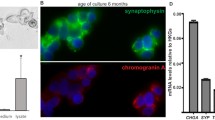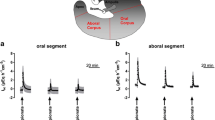Abstract
Histamine is a mast cell mediator released e.g. during food allergy. The aim of the project was to identify the effect of histamine on rat submucosal neurons and the mechanisms involved. Cultured submucosal neurons from rat colon express H1, H2 and H3 receptors as shown by immunocytochemical staining confirmed by reverse transcriptase polymerase chain reaction (RT-PCR) with messenger RNA (mRNA) isolated from submucosal homogenates as starting material. Histamine evoked a biphasic rise of the cytosolic Ca2+ concentration in cultured submucosal neurons, consisting in a release of intracellularly stored Ca2+ followed by an influx from the extracellular space. Although agonists of all three receptor subtypes evoked an increase in the cytosolic Ca2+ concentration, experiments with antagonists revealed that mainly H1 (and to a lesser degree H2) receptors mediate the response to histamine. In coculture experiments with RBL-2H3 cells, a mast cell equivalent, compound 48/80, evoked an increase in the cytosolic Ca2+ concentration of neighbouring neurons. Like the response to native histamine, the neuronal response to the mast cell degranulator was strongly inhibited by the H1 receptor antagonist pyrilamine and reduced by the H2 receptor antagonist cimetidine. In rats sensitized against ovalbumin, exposure to the antigen induced a rise in short-circuit current (I sc) across colonic mucosa-submucosa preparations without a significant increase in paracellular fluorescein fluxes. Pyrilamine strongly inhibited the increase in I sc, a weaker inhibition was observed after blockade of protease receptors or 5-lipoxygenase. Consequently, H1 receptors on submucosal neurons seem to play a pivotal role in the communication between mast cells and the enteric nervous system.









Similar content being viewed by others
References
Amstutz I, Diener M (1997) Inhibition of antigen-induced muscle contractions by inhibitors of thromboxane pathway in rat small intestine. J Vet Med 44A:349–359
Avemary J, Diener M (2010) Bradykinin-induced depolarisation and Ca2+ influx through voltage-operated Ca2+ channels in rat submucosal neurons. Eur J Pharmacol 635:87–95
Bakowski D, Parekh NB (2000) Voltage-dependent conductance changes in the store-operated Ca2+ current I-CRAC in rat basophilic leukaemia cells. J Physiol 529:295–306
Barry GD, Suen JY, Le GT, Cotterell A, Reid RC, Fairlie DP (2010) Novel agonists and antagonists for human protease activated receptor 2. J Med Chem 53:7428–7440
Bell MI, Richardson PJ, Lee K (2000) Histamine depolarizes cholinergic interneurones in the rat striatum via a H1-receptor mediated action. Brit J Pharmacol 131:1135–1142
Bezprozvanny I (2005) The inositol 1,4,5-trisphosphate receptors. Cell Calcium 38:261–270
Brandt EB, Strait RT, Hershko D, Wang Q, Muntel EE, Scribner TA, Zimmermann N, Finkelman FD, Rothenberg ME (2003) Mast cells are required for experimental oral allergen–induced diarrhea. J Clin Invest 112:1666–1677
Brandtzaeg P (2010) Food allergy: separating the science from the mythology. Nat Rev Gastroenterol Hepatol 7:380–400
Breunig E, Michel K, Zeller F, Seidl S, Hann von Weyhern CW, Schemann M (2007) Histamine excites neurones in the human submucous plexus through activation of H1, H2, H3 and H4 receptors. J Physiol 583:731–742
Buhner S, Schemann M (2012) Mast cell-nerve axis with a focus on the human gut. Biochim Biophys Acta 1822:85–92
Castro GA, Harari Y, Russell D (1987) Mediators of anaphylaxis-induced ion transport changes in small intestine. Am J Physiol 253:G530–G548
Crowe SE, Sestini P, Perdue MH (1990) Allergic reactions of rat jejunal mucosa. Ion transport responses to luminal antigen and inflammatory mediators. Gastroenterology 99:74–82
De Winter BY, Van den Wijngaard RM, De Jonge WJ (2012) Intestinal mast cells in gut inflammation and motility disturbances. Biochim Biophys Acta 1822:66–73
Frieling T, Cooke HJ, Wood JD (1994) Neuroimmune communication in the submucous plexus of guinea pig colon after sensitization to milk antigen. Am J Physiol 267:G1087–G1093
Frings M, Schultheiß G, Diener M (1999) Electrogenic Ca2+ entry in the rat colonic epithelium. Pflügers Arch Eur J Physiol 439:39–48
Furness JB (2006) The enteric nervous system. Blackwell Publishing, Oxford
Hansen MB (2003) The enteric nervous system I: organisation and classification. Pharmacol Toxicol 92:105–113
Hawthorne AB, Boughton-Smith NK, Whittle BJR, Hawkey CJ (1992) Colorectal leukotriene B4 synthesis in vitro in inflammatory bowel disease: inhibition by the selective 5-lipoxygenase inhibitor BW4AC. Gut 33:513–517
Hill SJ, Ganellin CR, Timmerman H, Schwartz JC, Shankley NP, Young JM, Schunack W, Levi R, Haas HL (1997) International union of pharmacology. XIII. Classification of histamine receptors. Pharmacol Rev 49:253–278
Hug F, Diener M, Scharrer E (1996) Modulation by fish oil diet of eicosanoid-induced anion secretion in the rat distal colon. Z Ernahrungswiss 35:323–331
Ji Y, Sakata Y, Yang Q, Yang Q, Li X, Xu M, Yoder S, Langhans W, Tso P (2012) Activation of rat intestinal mucosal mast cells by fat absorption. Am J Physiol Gastrointest Liver Physiol 302:G1292–G1300
Kato Y, Kita Y, Nishio M, Hirasawa Y, Ito K, Yamanaka T, Motoyama Y, Seki J (1999) In vitro antiplatelet profile of FR171113, a novel non-peptide thrombin receptor antagonist. Eur J Pharmacol 384:197–202
Lazarov N, Rozloznik M, Reindl S, Rey-Ares V, Dutschmann M, Gratzl M (2006) Expression of histamine receptors and effect of histamine in the rat carotid body chemoafferent pathway. Eur J Neurosci 24:3431–3444
Lee KP, Yuan JP, Hong JH, So I, Worley PF, Muallem S (2010) An endoplasmic reticulum/plasma membrane junction: STIM1/Orai1/TRPCs. FEBS Lett 584:2022–2027
Liu S, Hu HZ, Gao N, Gao C, Wang G, Wang X, Peck OC, Kim G, Gao X, Xia Y, Wood JD (2003) Neuroimmune interactions in guinea pig stomach and small intestine. Am J Physiol Gastrointest Liver Physiol 284:G154–G164
Maruyama T, Kanaji T, Nakade S, Kanno T, Mikoshiba M (1997) 2-APB, 2-aminoethoxydiphenyl borate, a membrane-penetrable modulator of Ins(1,4,5)P3-induced Ca2+ release. J Biochem 122:498–505
Parekh AB (2006) On the activation mechanism of store-operated calcium channels. Pflügers Arch Eur J Physiol 453:303–311
Plenge-Tellechea F, Soler F, Fernadez-Belda F (1997) On the inhibition mechanism of sarcoplasmic or endoplasmic reticulum Ca2+-ATPases by cyclopiazonic acid. J Biol Chem 272:2794–2800
Raithel M, Winterkamp S, Pacurar A, Ulrich P, Hochberger J, Hahn EG (2001) Release of mast cell tryptase from human colorectal mucosa in inflammatory bowel disease. Scand J Gastroenterol 36:174–179
Sander LE, Lorentz A, Sellge G, Coėffier M, Neipp M, Veres T, Frieling T, Meier PN, Manns MP, Bischoff SC (2006) Selective expression of histamine receptors H1R, H2R, and H4R, but not H3R, in the human intestinal tract. Gut 55:498–504
Santos J, Guilarte M, Alonso C, Malagelada JR (2005) Pathogenesis of irritable bowel syndrome: the mast cell connection. Scand J Gastroenterol 40:129–140
Schemann M, Camilleri M (2013) Functions and imaging of mast cell and neural axis of the gut. Gastroenterology 144:698–704
Schemann M, Neunlist M (2004) The human enteric nervous system. Neurogastroenterol Motil 6(Suppl. 1):55–59
Schultheiss G, Hennig B, Schunack W, Prinz G, Diener M (2006) Histamine-induced ion secretion across rat distal colon: involvement of H1 and H2 receptors. Eur J Pharmacol 546:161–170
Stead RH, Colley EC, Wang BX, Partosoedarso E, Lin J, Stanisz A, Hillsley K (2006) Vagal influences over mast cells. Auton Neurosci Basic Clin 125:53–61
Wang YZ, Palmer JM, Cooke HJ (1991) Neuroimmune regulation of colonic secretion in guinea pigs. Am J Physiol 260:G307–G314
Wood JD (2004) Enteric neuroimmunophysiology and pathophysiology. Gastroenterology 127:635–657
Wood JD (2006) Histamine, mast cells, and the enteric nervous system in the irritable bowel syndrome, enteritis, and food allergies. Gut 55:445–447
Yamanaka K, Kitamura K (1987) Electrophysiological and mechanical characteristics of histamine receptors in smooth muscle cells of the guinea-pig ileum Eur. J Pharmacol 144:29–33
Acknowledgments
We thank Prof. A. Cavalié (University Homburg/Saar) for the generous support of RBL-2H3 cells. This study was supported by Deutsche Forschungsgemeinschaft, grant Di 388/13-1.
Author information
Authors and Affiliations
Corresponding author
Rights and permissions
About this article
Cite this article
Bell, A., Althaus, M. & Diener, M. Communication between mast cells and rat submucosal neurons. Pflugers Arch - Eur J Physiol 467, 1809–1823 (2015). https://doi.org/10.1007/s00424-014-1609-9
Received:
Revised:
Accepted:
Published:
Issue Date:
DOI: https://doi.org/10.1007/s00424-014-1609-9




